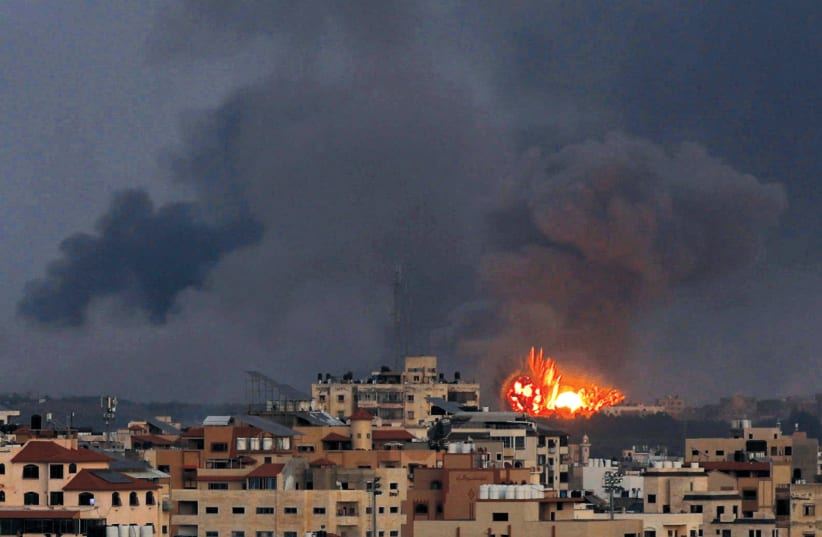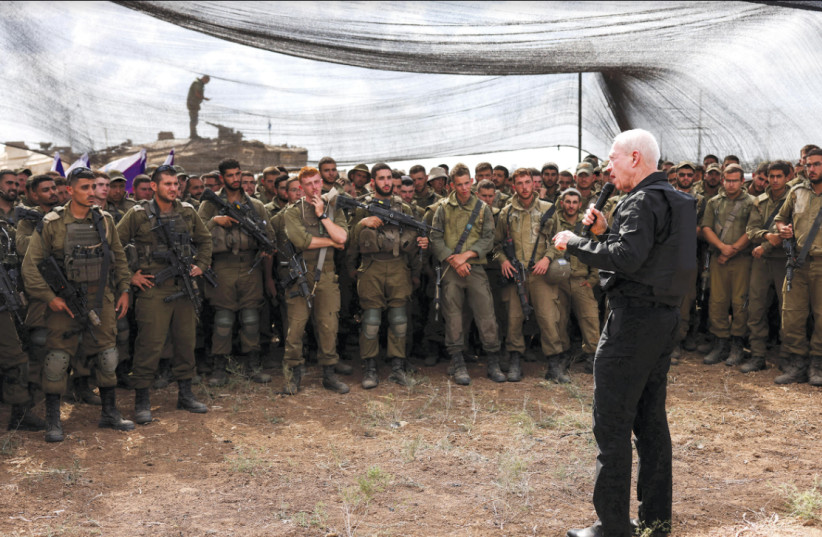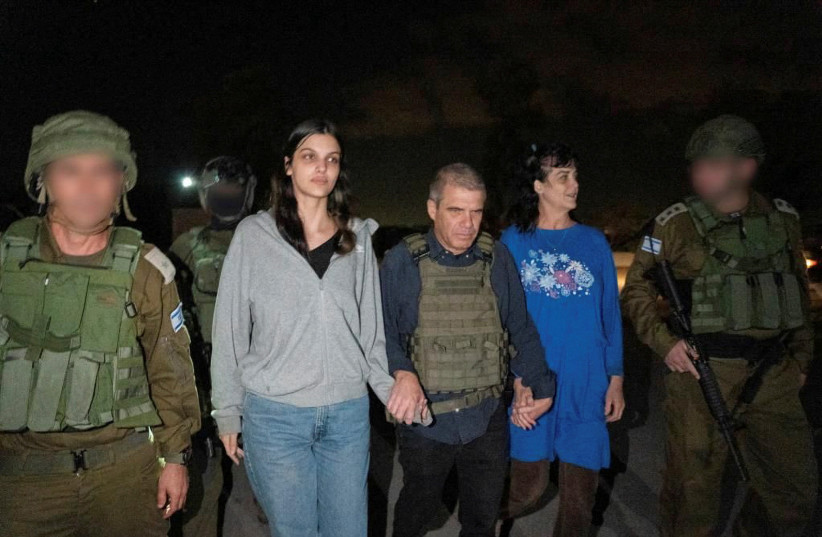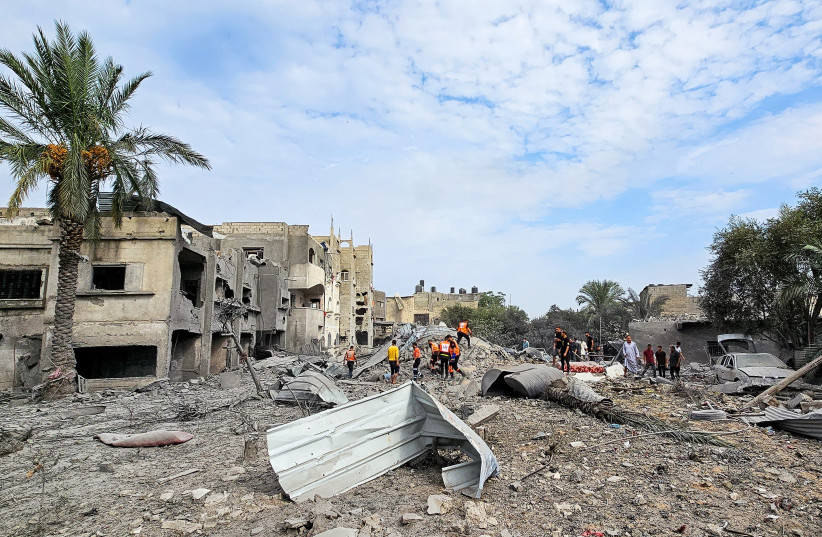The events of Saturday, October 7, 2023 will forever be seared in Israel’s collective memory. The trauma will last for generations to come, along with the heroism of the few who were left to fend for themselves, waiting for hours before the army sent reinforcements.
A regional military superpower was taken by surprise by a fanatical terrorist group when some 2,000 well-armed Hamas gunmen stormed across the border, wreaking death and destruction in army bases, towns, and kibbutzim along the length of the Gaza border.
At least 1,400 Israelis were killed, the majority of them civilians, many murdered with sadistic brutality.
Intelligence failure worse than Yom Kippur War
The intelligence failure was worse than the 1973 Yom Kippur War. At that time, warnings signs were given but largely ignored. The massacres of October 2023 occurred seemingly without any prior warning.
Hamas had convinced Israeli decision-makers that they were not seeking an escalation in their conflict. According to the misconception, as long as money from Qatar flowed and Gazan day laborers were allowed to work inside Israel, the border would remain quiet.
But it was all a ruse. For more than a year, the terror group had been planning a well-coordinated attack down to the last detail. Israel had no idea.
As the gruesome events unfolded on the morning of Simchat Torah, it was clear that what had happened was a mega event in the history of the modern Middle East. Nothing will be the same again. Despite the shock, the horror, and the grief, the nation rallied, determined that Hamas must be totally destroyed and its military and political leaders hunted down and killed. Hamas must be toppled from power and a new order must be created that removes forever the danger for Israelis who live close to the border.
The bombing of Gaza in the fortnight after the Hamas attack was at an unprecedented level. Some 360,000 reservists were mobilized – the largest call-up in the country’s history – many scrambling for flights from abroad to join their units at the front.
The Israel Security Agency, Shin Bet, has set up a designated task force to find and kill every member of Hamas’s Nukhba unit who participated in the October 7 attack and returned to Gaza.
More than a million residents of the northern Gaza Strip were ordered by the IDF to leave their homes and head south for their own safety. Most heeded the warning.
IDF Chief of Staff Lt.-Gen. Herzi Halevi met with IDF troops and expressed his confidence in their ability to carry out the mission they have been tasked with. “We will go into the Gaza Strip and destroy Hamas operatives, Hamas infrastructure, and we will remember the photographs and the sights of the fallen we witnessed two Saturdays ago. Gaza is complicated; Gaza is crowded. The enemy is preparing many things. But we are also planning things for the enemy. I really believe in you. With pride. With strength, you will emerge victorious.”
Kibbutz Be'eri, one of those hit hardest on October 7
Kibbutz Be’eri, a few miles from the Gaza border, was one of the 22 border communities overrun by Hamas terrorists, and one of those hit hardest on October 7.
The IDF opened the kibbutz farming community to the media a few days after the attack for the world to see the carnage firsthand.
The first thing that struck me was the stench. It was a smell I wasn’t familiar with: It was the smell of death. Even though the army had removed most of the bodies, it was believed that some remained buried under the rubble. The smell was overpowering.
A particularly heavy rocket barrage at 6:30 on the Saturday morning had sent residents fleeing to their bomb shelters or secure rooms. Half an hour later, some 90 well-armed Hamas terrorists who had infiltrated across the Gaza border reached the kibbutz. They killed the security guard at the entrance of the kibbutz and went door to door, killing entire families.
Be’eri’s five-man security team, hearing the gunshots, ran to engage the infiltrators but stood no chance against so many.
Men, women, and children were shot or stabbed to death. If families locked themselves in secure rooms designed to withstand rocket fire, the militants set the house on fire, choking those inside or forcing them to flee – easy targets for the waiting gunmen.
The charred remains of some homes stand next to other buildings where fierce exchanges of gunfire took place. They have been almost totally destroyed. The scene is one of utter destruction.
“The symbol of Saturday’s massacre is where we are standing now,” said Maj. Doron Spielman from the IDF spokesman’s unit, standing in front of the destroyed buildings.
“We found in this area bodies of children and babies that were grotesquely dissected. The madness, the rage, and the inhumanity of Hamas caused this. This nation is now going to put on military uniforms and do what we have to do make sure this is never going to happen again.”
On October 7, an IDF Special Forces team arrived a few hours after the terrorists reached the kibbutz, but they were soon pinned down. Many hours later, fresh reinforcements arrived. It took a full day of fighting to eliminate all the terrorists.
A number of residents – adults and children – were seized and taken to Gaza as hostages. At least 112 Be’eri residents were killed. The survivors have relocated to Dead Sea hotels or to the center of the country. It’s not clear when, or if, they will return.
One of those murdered in Be’eri was eight-year-old Emily Hand. Her father, Irish-born Thomas Hand, entered his bomb-proof, secure room at 6:30 on Saturday when the sirens sounded. Emily was at a sleepover at a friend’s house on the kibbutz. Then he heard shots.
“I could hear the gunfire getting closer. I called my ex-wife on the kibbutz to make sure she was in a safe room and had locked the door, and I told her to call the family where Emily was sleeping.”
After eventually emerging from his safe room, he was escorted by a senior kibbutz member to a room where a doctor was waiting, together with a psychiatrist and a social worker, and informed him that Emily had been killed. Thomas’s reaction was remarkable.
“I literally punched the air and shouted “Yes!” like I’d just scored a goal. Can you imagine the reaction of the panel: ‘Did he just say that?’”
Thomas explained why he was so “happy” to hear such tragic news.
“I knew the alternative for my daughter. I knew she’d either be found dead or kidnapped and taken to Gaza. And the thought of a little eight-year old child in the hands of those animals, those cowardly barbarians, being pushed around, yelled at in Arabic which she doesn’t understand. She’d be terrorized out of her life. My God, I can’t imagine what would have been going through her head, locked up in a small dark room with hardly any water or food. Can you imagine the sheer horror for an eight-year-old child? Yes, they’d be there for years. Who knows? I couldn’t have lived with that. Locked up like in the train wagons they used to deport the Jews to the concentration camps.”
Thomas said that the Hamas terrorists were very well organized.
“Hamas were there to kill and mutilate and kidnap,” he explained. “They caught the whole of Israel with their pants down. It’s shameful, to be honest. There was one team that kidnapped people and handed them over to another team on motorbikes who drove them back to Gaza.”
At least 220 hostages remain in captivity in Gaza. They include 30 children and 20 older people. Hamas released two hostages on Friday, October 20 – American citizens mother and daughter Judith and Natalie Raanan – who had been seized from Kibbutz Nahal Oz.
Hamas described the release as a humanitarian gesture, but Israeli officials interpreted the move as a transparent attempt to pressure Israel to delay a ground offensive and enter into negotiations over the release of more hostages in return for Palestinian security prisoners held in Israeli jails.
Gallant revealed Israel's war plans, objectives for Gaza Strip
As the preparations for a ground offensive were being finalized, Defense Minister Yoav Gallant revealed Israel’s war plans and list of objectives for the Gaza Strip.
Speaking at a meeting of the Knesset Foreign Affairs and Defense Committee, Gallant outlined Israel’s three-phase plan.
“We are currently in the first phase, which involves a military campaign aimed at targeting terrorists and disrupting Hamas’ infrastructure with precise air strikes,” he said.
“The second phase will be an interim period of lower-intensity war with a focus on eliminating pockets of resistance. The third and final phase will entail the establishment of a new security framework in Gaza, relinquishing Israel’s responsibility.”
A number of far-right coalition Knesset members have made no secret of the fact that they would like to renew Israel’s presence in Gaza, which ended with the 2005 disengagement when all troops withdrew and the 21 settlements were evacuated and demolished.
While Israel’s security cabinet has decided not to decide for now on the fate of the Gaza Strip after Hamas is toppled, Prime Minister Benjamin Netanyahu and National Security Council Director Tzahi Hanegbi both promised US President Joe Biden, German Chancellor Olaf Scholz, and British Prime Minister Rishi Sunak, who all visited Israel on solidarity visits, that Israel does not intend to control Gaza. Hanegbi reportedly told the visiting leaders that the most likely possibility was transferring control of Gaza after the war to the Palestinian Authority.
While the focus remained on Gaza, Hezbollah and Palestinian groups in south Lebanon escalated attacks on Israel’s northern border. The IDF retaliated with airstrikes and artillery fire, reportedly killing at least 30 Hezbollah operatives and destroying some of the organization’s military assets in southern Lebanon. Both sides have refrained from taking action that might lead to a full-scale war, but the IDF sent reinforcements to the border and warned Hezbollah against opening a second front and risking a much wider and much more dangerous regional conflagration that could drag in Iran and the US.
US deployed thousands of military personnel
The US redeployed thousands of sailors, warplanes, and two aircraft carriers to the eastern Mediterranean in an effort to keep a powder keg from exploding across the Middle East.
“To any country, any organization, anyone thinking of taking advantage of the situation, I have one word: Don’t!” Biden said. “Let there be no doubt: The United States has Israel’s back.” Becoming the first US president to visit Israel in wartime, he asked Congress to approve a $14 billion aid package as US Air Force planes began a round-the-clock airlift.
There was also a significant increase in violence in the West Bank.
More than 70 Palestinians were killed across Judea and Samaria during the first two weeks of the Gaza war. Troops arrested more than 375 Hamas fugitives.
And there was also an attack on Israel from an unexpected quarter when a US Navy warship intercepted missiles that had been fired by Iranian-backed Houthi rebels in Yemen.
During the first two weeks of the war, Israel’s defense minister, the army’s chief of staff, the director of IDF military intelligence directorate, and the Israel Security Agency Shin Bet director all accepted responsibility for their part in the events of October 7.
Absent from the list was Benjamin Netanyahu. A poll on October 20 showed an overwhelming majority of the Israeli public – 80% – believed that the prime minister must also accept responsibility for what happened on Black Sabbath.
The catastrophe of October 2023 will be Benjamin Netanyahu’s legacy.
It is unconscionable that the man who was leading the country when the attack took place and has been prime minister for the last 14 years almost uninterrupted will be able to continue as Israel’s leader.
Some called on him to resign immediately and hand over the conduct of the Gaza war to others. However, this is a minority view. The overwhelming consensus among Israelis at this juncture is that now is the time to focus on toppling the Hamas regime in Gaza. The ramifications of the colossal failure surrounding the events on Saturday, October 7, will have to wait until the end of the military operation.
A poll on October 20 indicated a seismic political shift: in the event of new elections. Current coalition parties would receive only 43 seats in the 120-seat Knesset parliament as opposed to 68 for current opposition parties, with nine seats for Hadash-Ta’al and the United Arab List.
For the duration of the war, unity is the order of the day.
The centrist National Unity Party, led by former top general Benny Gantz, agreed to join the government, and all other issues, including the controversial judicial overhaul, are on hold.
Gantz and his party lawmaker Gadi Eisenkot, another former IDF chief of staff, joined Netanyahu and Gallant in the war cabinet.
“We put all other considerations aside, as the fate of our country hangs in the balance,” Netanyahu said.
“This isn’t a political partnership, this is a shared fate. We are lending a shoulder and are enlisting in the war that is being prosecuted [implemented] by the prime minister and the defense minister,” said Gantz.
The leader of the opposition, former prime minister Yair Lapid, head of the centrist Yesh Atid, refused to join the unity coalition after Netanyahu rejected his call to exclude far-right ministers Bezalel Smotrich and Itamar Ben-Gvir from the government.
“Let’s kick out... the extremists who won’t let the war be waged, and we will join forces in a sane, broad, strong government that can make decisions effectively,” Lapid said. “Until then, we will continue to back every action that leads to the eradication of the loathsome Hamas terrorists, until total victory.”
Yisrael Beytenu also remains in the opposition, and party leader Avigdor Liberman said he would only join the unity government if he is offered a seat in the war cabinet.
The unity government will only last for the duration of the conflict.
The bad blood between Netanyahu and Gantz remains and will likely never disappear. At the conclusion of the war, the National Unity Party will return to the opposition and join the call for answers from the political, military, and intelligence echelons.
The Commission of Inquiry set up after the Yom Kippur War, when the invasion by the Egyptian and Syrian armies took Israel by surprise, eventually led to the resignation of prime minister Golda Meir.
The trauma of Black Sabbath is much worse, considering that this time the bulk of the fatalities were civilians, many who were left to fend for themselves and were killed in the most horrific circumstances. And there is also the fact that the terrorists managed to seize more than 200 civilians.
The difficult questions will be addressed in time. But for now, the task at hand is to destroy Hamas. ■



